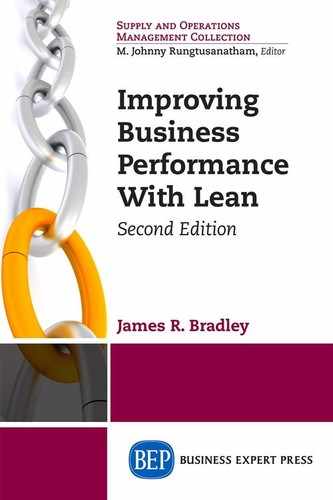PART II
Lean Tools
Once a process is revealed through its map and its lead time and value-added times, nonvalue-added times, and value-added ratio are computed, opportunities for reducing lead time can be brainstormed. One approach to generating improvement ideas is to, first, convene the improvement team for a brainstorming session to solicit team members’ ideas for reducing lead time. A brainstorming session is effective because one team member’s idea can spark additional ideas from other members. Of course, the typical rules of brainstorming apply—most importantly, that no idea is critiqued or vetted for feasibility during this stage. Criticism can stifle the input of more timid team members, and what is needed at this point is a constructive atmosphere that invites participation. Vetting ideas for feasibility can be done later, and sometimes ideas that seem crazy and infeasible actually turn out to be feasible ideas that nobody ever tried because they thought they were infeasible, so it is important that these ideas are not killed early on. At the least, wild ideas, even if infeasible, can induce other feasible improvements. Subsequent to brainstorming, more structured input can be generated by focusing on the process steps and waiting steps that have the longest lead time or, in other words, the process steps that present the greatest opportunity. If no ideas were spontaneously generated during brainstorming for these critical steps, then this is an opportunity to address the main culprits of long lead time.
Even without formal exposure to tools used in Lean to reduce lead time, people often intuitively have good ideas for reducing lead time. Still, familiarity with a broader tool kit provides greater opportunity for improvement, and enlarging your tool kit is the focus of Part II of this book.
The goal is to identify and eliminate the seven types of waste that were previously mentioned. The tactics for doing so and reducing lead time fall into these categories:
1.Simplify
2.Streamline
3.Standardize
4.Use visual systems
5.Mistake-proof processes and product designs
6.Synchronize
7.Collocate
8.Reduce changeover time
These tactics are not aligned with the seven types of waste in a one-to-one fashion. Rather any action falling into one of the preceding categories often reduces multiple types of waste. The best way to describe which types of waste are reduced is to describe each of these tactics in the context of real situations where they have been applied. In this part of the book, we do just that for each of the eight improvement tactics previously listed.
We will also observe that the categories do not separate improvements made in Lean projects in a mutually exclusive manner; some actions might fairly be put into multiple categories. That observation motivates us to say that a main purpose of the category labels is not only to neatly classify Lean tools but also to remind us of the different ways that we can improve processes. The category labels are purposefully stated as directives, which if followed will reduce lead time and improve processes.
